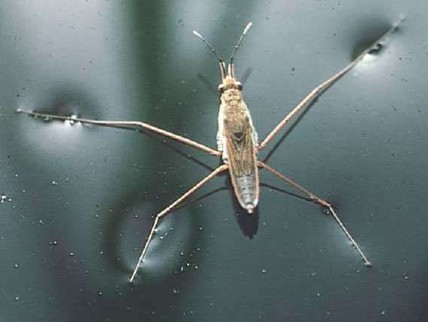5.2.1.P5
For an animal the size of a human, surface tension seems to be a rather small and insignificant force (though it plays an important if unnoticed role in our breathing). But as animals get smaller, surface tension gets increasingly significant. (The weight of the animal goes down with the cube of the size while the surface tension only decreases linearly.) For animals like the basilisk lizard and the jacana (bird), they appear to be able to walk on water (perhaps with a little help from floating vegetation). But for a small insect like the water strider (shown in the figure at the right), the surface tension of the water serves to support the insect perfectly satisfactorily.
|
 |
The water strider’s feet are coated with waxy, hydrophobic materials. This effectively eliminates the adhesion between the insects leg and the water, so the water doesn't "wet" the leg and the water's surface tension can dominate. We can see from the photo that the strider's leg doesn't just press down into the water on a sharp dot. Rather, the long part of the leg presses into the water, increasing the contact length with the water.
 |
A. Let's model the contact between the strider's leg and the water as a cylinder imbedded in the water along its long axis as in the figure at the left. The strider's leg exerts a force down on the surface of the water. Consider the leg and the bit of water under the leg. Do a free-body diagram for both the leg and the bit of water. What holds the water up?
B. A typical water strider such as the one shown in the photo might have a mass of 10 mg and a length of 1 cm. The coefficient of surface tension of clean water,γ, at 20 C (ST depends strongly on both temperature and dissolved chemicals) is about 0.07 N/m. Estimate how much of the strider's legs have to be touching in order to hold it up.
C. Knowing how much you actually weigh, and using the surface tension coefficient you have found, how long would your shoes have to be to let you walk on water?
|
Comments (0)
You don't have permission to comment on this page.